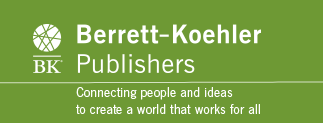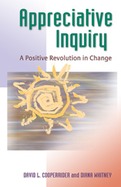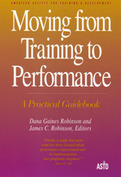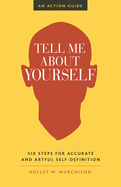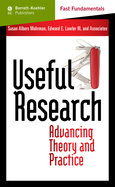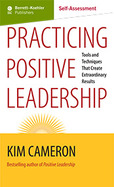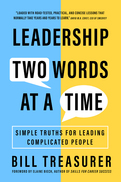2005
In response to today's rapidly changing business climate, traditional human resource and training departments are undergoing dramatic structural changes in several areas. One of these is a transition away from focusing on what employees need to learn, to a focus on improving people's performance to meet key organizational needs.
In this new book, Moving from Training to Performance, editors Dana Gaines Robinson and James C. Robinson point out how human resource departments are changing direction by partnering with management and linking initiatives to the business needs of the organization. "Clearly there has never been a greater opportunity for training departments to transform themselves into departments which partner with client-managers for the purpose of achieving exceptional performance and business results," say the editors. But what is required to successfully make the transition?
Organized around the three levels of alignment-the process level, the organization level, and the job/performer level-Moving from Training to Performance offers practical, action-oriented techniques for making the transition from some of the most highly respected contributors in the field. Chapters by such industry experts as Geoff Bellman, Geary Rummler, Paul Elliott, Jim Fuller, Harold Stolovitch, and Erica Keeps are paired with real-life case studies of organizations such as Johnson & Johnson, Andersen Consulting, Prudential HealthCare System, Steelcase, PNC Bank, and others that have achieved exceptional results by successfully making the transition to performance at each level of alignment. The book also offers a special "Quick Read" summary of key points from each chapter, a complete glossary of terms, and a comprehensive resource directory of contacts in the field.
Whether your goal is to increase revenue or improve customer satisfaction, Moving from Training to Performance shows how today's performance improvement departments can take a more active role in helping organizations meet their service and financial goals.
- Edited by the authors of the bestselling Performance Consulting: Moving Beyond Training (over 30,000 copies sold)
- Co-published with the American Society for Training and Development
- Provides practical tools that show how human resource departments can make the transition to a performance improvement function.
- Features chapters by some of the most highly respected professionals in the field of training and performance
Sometimes you get only one chance. A good introduction can create connections and open doors. A bad one can make conversation fizzle and opportunities fade. What you need is a story that tells who you are—authentically, compellingly, and concisely—and can be adapted to fit any situation. Created for dynamic beings constantly redefining themselves, their work, and the world around them, Tell Me About Yourself pairs interviews and case studies with a simple, scalable framework, helping you craft and deliver comprehensive, compelling, and generally kick-ass introductions and personal stories for yourself, your team, or your company. In an ever-changing innovation economy and a climate that demands we put our best foot forward to create change, there's no better time to learn how to articulate your usefulness to the world.
Product: Online streamed self-assessment application (not downloaded), limited one-year subscription (5 tests or 12 months, whichever comes first), password controlled
Duration: 68 questions in ten categories (the first five related to Positive Leadership book; the second five related to the Practicing Positive Leadership book): 1) Positive Climate, 2) Positive Relationships, 3) Positive Communications, 4) Positive Meaning, 5) Personal Managemnt Interviews, 6) Create a Culture of Abundance, 7) Developing Positive Energy, 8) Accomplishign Everest Goals, 9) Deliver Negative Feedback Positively, 10) Apply in Organizations. The self-assessment takes 15-20 minutes to complete.
Results: You will receive a radar graph that shows your relative strenths and weaknesses in the ten areas described above. The author also offers interpretation of your results and provides references for each of the ten areas in his two books, Positive Leadership (questions 1-24) and Practicing Positive Leadership (questions 25-68). By reading your results, you can gain important insights on how to practice positive leadership in your organization. The author addresses next steps both for the individual and groups. There are also opening and closing statements from the author, the ability to compare current and former results, and a print option.
BASED ON THE BOOK: PRACTICING POSITIVE LEADERSHIP Over a decade ago, Kim Cameron and some colleagues decided that rather than analyze what went terribly wrong with organizations and how to prevent it, they would look at what went extraordinarily right and how to replicate it. This was the birth of positive organizational scholarship, a new field that focused on what they called "positive deviance"-outcomes that far exceeded normal success.
In his previous book Positive Leadership, Cameron outlined four leadership strategies-Positive Climate, Positive Relationships, Positive Communications, and Positive Meaning-that characterize exceptionally high-performing organizations. Here he takes these strategies further by laying out tactics for implementing them:
- Creating a Culture of Abundance: five specific steps leaders can take to create an organizational culture that enables members to experience vitality, flourishing, and engagement
- Developing Positive Energy Networks: tools and practices for cultivating positive energy in oneself and for diffusing it throughout the organization
- Delivering Negative Feedback Positively: techniques for delivering difficult but necessary messages in ways that build and strengthen relationships
- Establishing and Achieving Everest Goals: guidelines for setting goals that have all the characteristics of SMART goals but go far beyond them
- Applying Positive Leadership in Organizations: a powerful tool for determining exactly how to implement positive leadership practices in the particular circumstances of your organization
Study after study (some of which are cited in the book) has shown that companies practicing positive leadership far outperform their competitors. So virtue may be its own reward, but it also delivers breakthrough results that any organization can achieve thanks to Kim Cameron's concise, how-to guide.
PURCHASER AND USER NOTE: If you are an individual consumer newly purchasing the assessment, go directly to the shopping cart by clicking the "add to cart" icon to your left. If you are a member of an organization that has purchased a bulk order, or if you already bought the assessment in the last 12 months and are retaking it now using the original Access Key to retake the assessment please log in here. New registrants: Please enter your "Access Key" into the input field to enter the self-assessment for the first time. A note to frequent purchasers: You cannot use your current bkconnection.com password for this product; you must create and use a new password. For any questions, please contact the support desk at 800-929-2929 (8 am-9 pm Eastern U.S. time, Monday through Friday), or [email protected]. Thank you.
Congratulations, new leader! You've joined the ranks during an exceptionally complicated time.
Our current workplace climate is fraught with political divisions, economic disparities, and ever-shifting social dynamics. Leaders are managing remote teams across larger geographic distances and facing new roadblocks to onboarding, giving performance feedback, and nurturing healthy relationships.
Leadership Two Words at a Time speaks directly to the plight of the new leader and is divided into three parts: Leading Yourself, Leading People, and Leading Work. Rather than overintellectualize the practice, Bill Treasurer breaks up the concept into essential and understandable learning nuggets-summed up by two-word headers-that provide the practical guidance and support that leaders often don't get. The result is time-tested wisdom that new leaders can grasp immediately and implement easily-and, with a little practice, master completely. Consider it a personal leadership playbook.
This book gives you the basic building blocks to gain both competence and confidence, take on greater responsibility, and learn what it takes to be and stay a leader.
